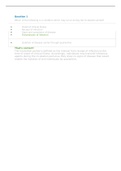Examen
NR 503 Week 4 Midterm Review Guide (Chapter 5– 6) | Student Consult Questions with Rationale | 100% Correct Solutions
- Cours
- Établissement
Which of the following is a condition which may occur during the incubation period? • Onset of clinical illness • Receipt of infection • Signs and symptoms of disease • Transmission of i nfection That's correct! The incubation period is defined as the interval from receipt of infection to t...
[Montrer plus]












